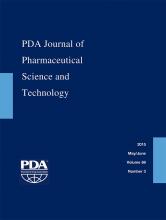Abstract
Nanoparticle Tracking Analysis (NTA) is an emerging analytical technique developed for detection, sizing, and counting of sub-micron particles in liquid media. Its feasibility for use in biopharmaceutical development was evaluated with particle standards and recombinant protein solutions. Measurements of aqueous suspensions of NIST-traceable polystyrene particle standards showed accurate particle concentration detection between 2 × 107 and 5 × 109 particles/mL. Sizing was accurate for particle standards up to 200 nm. Smaller than nominal value sizes were detected by NTA for the 300–900 nm particles. Measurements of protein solutions showed that NTA performance is solution-specific. Reduced sensitivity, especially in opalescent solutions, was observed. Measurements in such solutions may require sample dilution; however, common sample manipulations, such as dilution and filtration, may result in particle formation. Dilution and filtration case studies are presented to further illustrate such behavior. To benchmark general performance, NTA was compared against asymmetric flow field flow fractionation coupled with multi-angle light scattering (aF4-MALS) and dynamic light scattering, which are other techniques for sub-micron particles. Data shows that all three methods have limitations and may not work equally well under certain conditions. Nevertheless, the ability of NTA to directly detect and count sub-micron particles is a feature not matched by aF4-MALS or dynamic light scattering.
LAY ABSTRACT: Thorough characterization of particulate matter present in protein therapeutics is limited by the lack of analytical methods for particles in the sub-micron size range. Emerging techniques are being developed to bridge this analytical gap. In this study, Nanoparticle Tracking Analysis is evaluated as a potential tool for biologics development. Our results indicate that method performance is molecule-specific and may not work as well under all solution conditions, especially when testing opalescent solutions. Advantages and disadvantages of Nanoparticle Tracking Analysis are discussed in comparison to other analytical techniques for particles in the sub-micron size range.
- © PDA, Inc. 2015
PDA members receive access to all articles published in the current year and previous volume year. Institutional subscribers received access to all content. Log in below to receive access to this article if you are either of these.
If you are neither or you are a PDA member trying to access an article outside of your membership license, then you must purchase access to this article (below). If you do not have a username or password for JPST, you will be required to create an account prior to purchasing.
Full issue PDFs are for PDA members only.
Note to pda.org users
The PDA and PDA bookstore websites (www.pda.org and www.pda.org/bookstore) are separate websites from the PDA JPST website. When you first join PDA, your initial UserID and Password are sent to HighWirePress to create your PDA JPST account. Subsequent UserrID and Password changes required at the PDA websites will not pass on to PDA JPST and vice versa. If you forget your PDA JPST UserID and/or Password, you can request help to retrieve UserID and reset Password below.






